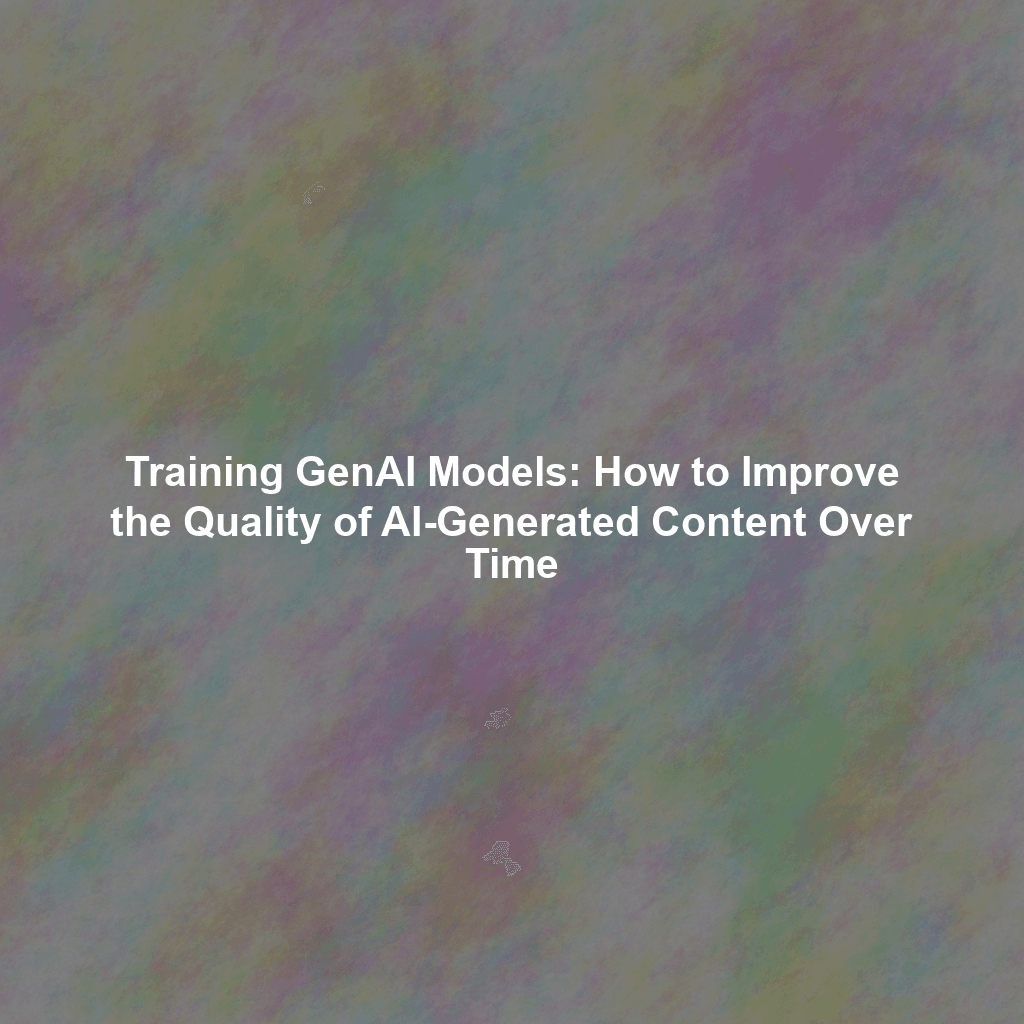Understanding the Foundation: How GenAI Models Learn
At its core, a GenAI model is a sophisticated algorithm trained on massive datasets of text, code, images, and other media. This training process allows the model to identify patterns, relationships, and structures within the data. There are several key phases to this training:
Data Ingestion and Preparation
This is the foundation. The model needs a vast and diverse dataset related to the type of content it’s intended to generate. The data needs to be meticulously cleaned, formatted, and pre-processed to ensure consistency and quality. Imagine feeding a student a textbook with countless errors; their learning would be severely hindered. The same principle applies to GenAI.
Model Training
During training, the model learns to predict the next word (or element) in a sequence based on the preceding words. This is often achieved through techniques like transformer networks and recurrent neural networks (RNNs). The model iteratively adjusts its internal parameters to minimize the difference between its predictions and the actual data. This “learning” process requires significant computational power and time.
Fine-tuning
Once the initial training is complete, the model can be further fine-tuned on a smaller, more specific dataset to improve its performance in a particular domain. For example, a model trained on general text data could be fine-tuned on medical literature to generate more accurate and relevant medical content.
The Human vs. AI Content Quality Debate
While GenAI is improving rapidly, it still faces challenges when compared to human writers. Here’s a breakdown across key dimensions:
Creativity and Originality
Human: Naturally capable of original thought, innovative ideas, and injecting personal experiences.
AI: Primarily relies on existing patterns in its training data, often leading to derivative or predictable content. While some models can generate surprising outputs, true originality remains elusive.
Style and Tone
Human: Can adapt writing style and tone to suit different audiences and contexts, incorporating emotion and personality.
AI: Can be programmed to mimic certain styles, but often struggles with subtlety, nuance, and genuine emotional connection. Often produces bland or generic output without careful prompting.
Grammar and Accuracy
Human: Prone to occasional errors, especially under pressure. But usually posses strong inherent understanding of grammar rules.
AI: Generally strong in grammar and syntax due to extensive training. Can still produce factual inaccuracies or illogical statements, especially on topics outside its training domain.
SEO Optimization
Human: Can strategically incorporate keywords and optimize content for search engines while maintaining readability and user experience.
AI: Can be instructed to optimize for specific keywords, but requires human oversight to ensure the content is engaging and provides genuine value to users. Keyword stuffing can be a problem if not properly managed.
E-E-A-T (Experience, Expertise, Authoritativeness, Trustworthiness)
Human: Can demonstrate E-E-A-T through their experience, qualifications, and reputation. Providing personal experience and stories.
AI: Struggles to establish E-E-A-T as it’s an artificial entity. Requires careful attribution and human oversight to ensure accuracy and credibility of content.
Improving AI-Generated Content Quality: A Practical Guide
Businesses can actively improve the quality of AI-generated content by focusing on the following key areas:
Data Refinement: The Garbage In, Garbage Out Principle
The quality of the training data is paramount. Focus on:
- Curating high-quality datasets: Prioritize authoritative, accurate, and well-written sources.
- Filtering out biased or irrelevant data: Remove data that could lead to skewed or inappropriate outputs.
- Augmenting data with specific examples: Provide examples of the desired style, tone, and format.
Implementing Feedback Loops: Continuous Learning
Establish a system for gathering feedback on AI-generated content and using that feedback to refine the model. This can involve:
- Human review and editing: Subjecting AI-generated content to thorough human review to identify and correct errors, improve style, and add context.
- User feedback: Collecting feedback from users on the helpfulness, accuracy, and overall quality of the content.
- Reinforcement learning: Training the model to reward desired behaviors and penalize undesirable ones based on human feedback.
Strategic Prompt Engineering: Guiding the AI
The prompts you provide to the GenAI model have a significant impact on the output. Focus on creating prompts that are:
- Clear and specific: Clearly define the desired topic, audience, and purpose of the content.
- Detailed and contextual: Provide enough context and background information to guide the model.
- Iterative: Experiment with different prompts and refine them based on the results.
Combining Human and AI Strengths: A Collaborative Approach
The most effective approach often involves combining the strengths of both humans and AI. Use AI to generate initial drafts, conduct research, and automate repetitive tasks. Then, leverage human expertise to refine the content, add creativity, and ensure accuracy.
Conclusion: The Future of AI-Enhanced Content Creation
GenAI is a powerful tool, but it’s not a replacement for human creativity and expertise. By understanding how these models are trained and implementing strategies for data refinement, feedback loops, and strategic prompt engineering, businesses can significantly improve the quality of AI-generated content. The future of content creation lies in a collaborative approach that leverages the strengths of both humans and AI to deliver engaging, informative, and valuable experiences to audiences.
 Skip to content
Skip to content

